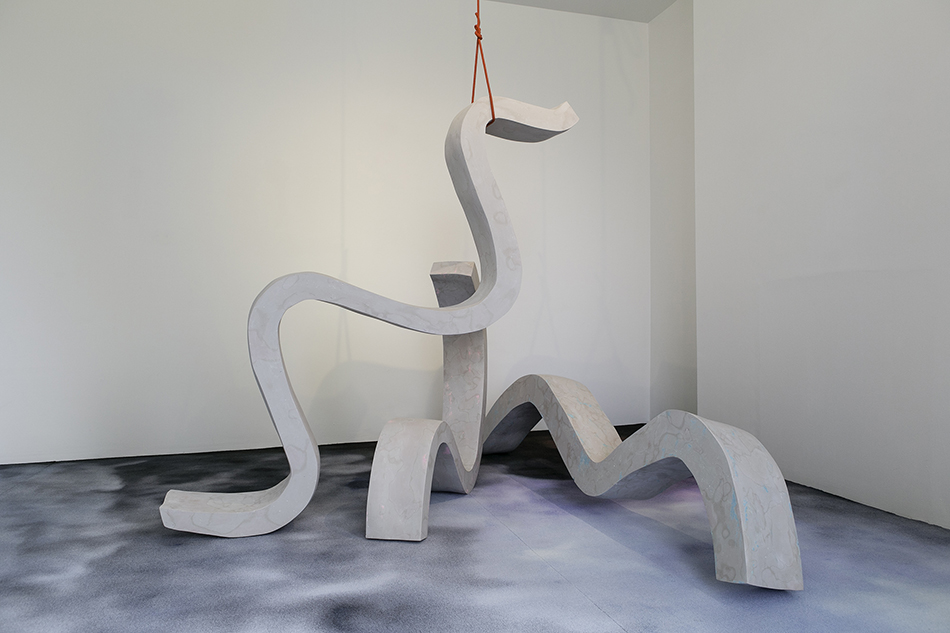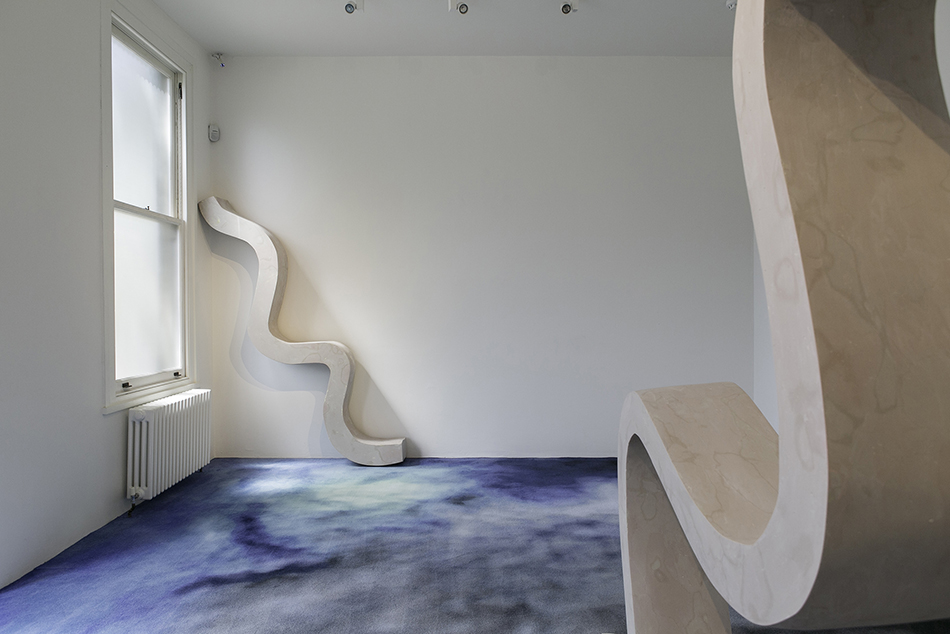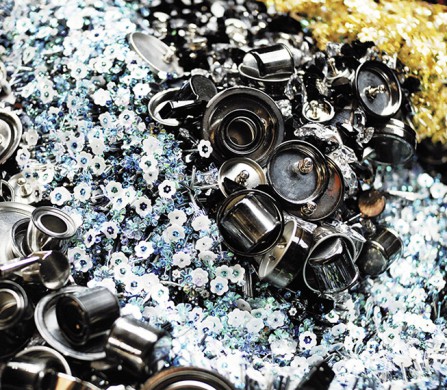Julia Crabtree and William Evans, following a six month stint as Nina Stewart Artists-in-Residence at the South London Gallery, revealed their latest installation in June. Their collaborative work, titled Antonio Bay, delves further into the relationship between the body and screen, and investigates the ever-growing influence of technology on visual culture. Antonio Bay combines the dynamics of traditional sculpture techniques with an experimentation with digital prints and CGI technologies. Schön! sits down with the artists to discuss the installation.
How has your ongoing collaborative relation developed over the course of the past few years?
I think when you approach or develop a collaborative working relationship, over time you need to define how it works, or at least you begin to understand it. Quite a few of our contemporaries collaborate, it seems that either the collaboration is about bringing together very clear aspects of individual practices so the actual collaborative work could be broken down into the individual contribution or else you work on the same thing together, so there is no divide…like classic literary duos such as Tweedle Dee and Tweedle Dumb or Rosencrantz and Guildenstern where the individuals in the collaboration are interchangeable with each other, you don’t know where one begins and the other ends. Of course there are varying degrees and cross overs in these definitions/divisions, but for us it’s very much about having a dialogue through making and working together – the work is a product of that process, a balance of planning and chance –
It’s like the way that if you describe something to two people they’ll both have a different idea or image in their head – so how do you realize a singular entity out of this. It means that what we end up with is beyond what either of us would have individually imagined. I think that’s maybe why the work has become more and more abstract, it’s interesting where the more intuitive and abstract cross overs are within the synthesis of our practice.
In regards to plans for the future, we’ve begun exploring 3D printing technologies. It feels a natural continuation of our work but it’s very early days.
As part of the Nina Stewart Artist Residency you received mentoring from artists and curators. How has this residency panned out?
It’s been amazing, particularly working with the curatorial team at SLG; Margot Heller, Simon Parris and Anna Gritz. Being able to work in both a critical and nurturing environment over such an extended period of time has really enabled us to develop work that not only responded to the physical aspects of the space but also engaged with the people driving it. We’ve been able to make more in the last 6 months that we did over the whole 2 year course at Slade.
How do you see the future of digital art? How has it evolved since you started?
This is quite a big question. If you just think about how much we’ve changed over the last five years because of the developments and daily incorporation of digital technologies it’s incredibly exciting to think about where that can go. For us our interest is in the relationship between the body and the screen – we’re really interested in how the screen enables you to inhabit multiple spaces at once, you can physically be sitting in your living room, while drawn into the narrative space of a film on TV while socialising online, it’s fascinating.
The title of the exhibition Antonio Bay, took inspiration from John Carpenter’s work, The Fog. What works, mediums, artists influence your work?
For us we like to mix a lot of different references, from B-movies to art history, to loosely quote Kathy Noble’s essay from our SLG publication, it’s like culture being put through a digital blender.
We initially began looking at CGI smoke and fog as part of our research into dry ice and other theatrical staging devices. The Fog is a really interesting reference point as in the film the fog is actually the protagonist…
Smoke or Fog – this ethereal, atmospheric, intangible environment becoming a ‘thing’ is interesting to us, and then not only this ‘thing’ but this amorphous, consuming threat, these characteristics worked with our research into the material and immaterial.
You use a variety of materials in your work from polystyrene, to car body filler, what does the physical production phase of your work involve?
The making process is actually deceptively laborious. With the recent sculptures at SLG, each single form is probably the equivalent of 100 hours work. We make a lot, it’s a very important aspect of our practice, and then when we exhibit we edit a lot out.
You work with a type of CGI called Fluid Dynamics, how did you come to start working with this medium?
We initially began by looking into how to create CGI dry ice. There are a variety of ways that this can be done with thinking particles and emitters etc. but because we wanted it to behave realistically and simulate a realistic movement through a space the only way this could be done (or at least that we know of) was using plug-ins for CGI programmes that used fluid dynamics to calculate the simulation.
How important is it for you to build a visual narrative in your work?
Very important. To some extent we kind of see our work as an unpacking of a cinematic image into a physical space, as a fluid movement from 2D to 3D. So it’s important that those elements that sustain the narrative of film are some how in the piece, some how create a rhythm or momentum. More and more music has begun to play a part in this, to signal the passage of change and a shift in a mood or atmosphere.
Antonio Bay is on show at the South London Gallery until 14th September. For more information click here.
Words / Tam Hashim

Discover the brand new Schön! Issue 25 #Drama.
Now available in print, as an ebook, online and on any mobile device.
















